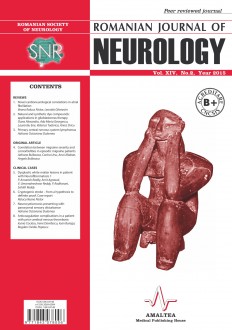SELECT ISSUE

Indexed

| |

|
|
|
| |
|
|
|

|
|
|
|
|
|
| |
|
|
HIGHLIGHTS
National Awards “Science and Research”
NEW! RJN has announced the annually National Award for "Science and Research" for the best scientific articles published throughout the year in the official journal.
Read the Recommendations for the Conduct, Reporting, Editing, and Publication of Scholarly work in Medical Journals.
The published medical research literature is a global public good. Medical journal editors have a social responsibility to promote global health by publishing, whenever possible, research that furthers health worldwide.
CORRELATION BETWEEN MIGRAINE SEVERITY AND COMORBIDITIES IN EPISODIC MIGRAINE PATIENTS
Adriana Bulboaca, Corina Ursu, Ana Uifalean and Angelo Bulboaca
ABSTRACT
Introduction. Migraine is an important cause of disability that affects the quality of life producing a substantial social impairment.
Objectives. The aim of this study was to evaluate the correlation between migraine severity and comorbidities in patients with episodic migraine.
Methods. 2 groups of patients were included in the study: group 1 – control group (healthy subjects, n = 50), and group 2 – study group (patients with episodic migraine attacks, n = 65). Both groups were assessed for nonmodifiable risk factors (age), and modifiable risk factors: BMI (body mass index), lipids profiles (LDL-cholesterol, HDL-cholesterol, triglycerides), inflammatory parameters (C reactive protein and fi brinogen), and endothelial dysfunction (nitric oxide synthesis expressed as NOx). The migraine was diagnosed according to ICHD-2 (International Classification of Headache Disorders) and the severity was evaluated by MIDAS (Migraine Disability Assessment Scale). The study group was compared with control group. The parameters that showed statistic significance were correlated with MIDAS scale.
Results. There was a significant correlation between the severity and frequency of migraine attacks (evaluated by MIDAS scale) and BMI. The subgroup with higher inflammatory parameters and decreased NOx had an increased MIDAS score.
Conclusions. The connection between obesity, inflammatory parameters and migraine may be useful for new prophylaxis potent therapies. The individual personalized therapies according with particular risk factors of each patient may be a chance for better results. Identification and control of risk factors in migraine patients may be particularly important.
Keywords: migraine, risk factors, obesity, inflammation
Full text | PDF
